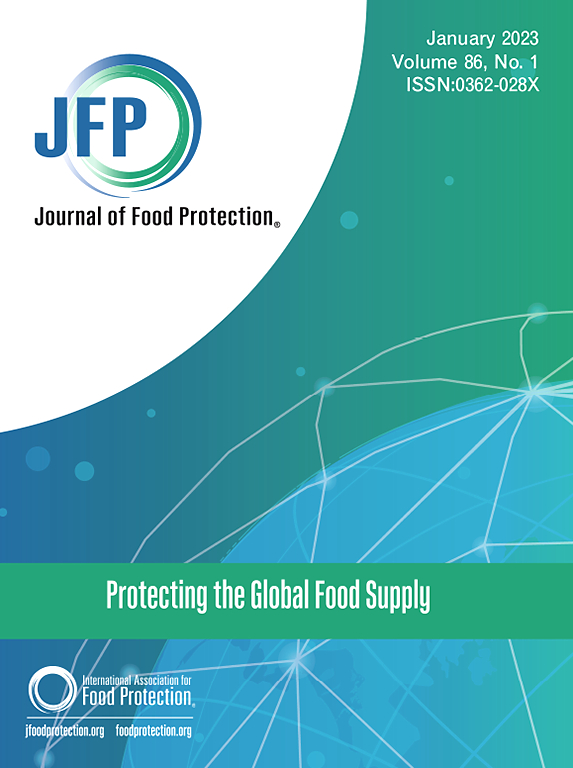Escherichia coli Survival on Dry Bulb Onions Treated with Crop Protection Sprays Prepared using Contaminated Water in the Treasure Valley Growing Region
IF 2.1
4区 农林科学
Q3 BIOTECHNOLOGY & APPLIED MICROBIOLOGY
引用次数: 0
Abstract
Contaminated agricultural water has been implicated in produce-associated outbreaks, including dry bulb onions (Allium cepa). This study was designed to quantify risks associated with contaminated water used to prepare crop protection sprays applied immediately before the onset of field curing of dry bulb onions. Laboratory experiments determining the behavior of Salmonella and Escherichia coli in crop protection chemical solutions were performed to guide selection for field use. Field trials were conducted (2022, 2023) in eastern Oregon (Treasure Valley) using two onion cultivars (‘Red Wing’ and ‘Cometa’) inoculated with a rifampicin-resistant E. coli cocktail (3–4 log CFU/100 mL) suspended in fungicide solution or clay suspension, and applied with a backpack sprayer at the end of the growing season. Onions were sampled through the next 4 weeks of field curing and after 1 and 4–5 mos of postharvest storage. In 2022, onions were initially contaminated at a maximum cell density of 48 MPN/onion (Geometric mean (GM): 3.7 MPN/onion). At the end of curing, a single onion (out of 320) tested positive at 2 MPN/onion. In 2022, E. coli was not detected during postharvest storage (n = 160). In 2023, the application of contaminated sprays resulted in a maximum contamination of 275 MPN/onion (GM: 8.6 MPN/onion). At the end of the 2023 curing period, three out of 320 onions (0.9%) had detectable levels of E. coli (1–2 MPN/onion). Three ‘Cometa’ onions from the same plot that were treated with fungicide were positive for E. coli after 5 months of postharvest storage (2, 11, and 83 MPN/onion). These field trials indicate field curing conditions in the Treasure Valley help mitigate risks associated with contaminated water used for applying crop protection sprays. E. coli was detected on a small percentage of onions at low cell density after curing. The single onion with elevated E. coli populations after postharvest storage had internal damage characteristic of bacterial rot.
宝藏谷种植区使用受污染的水制备农作物保护喷雾剂处理过的干球茎洋葱上的大肠杆菌存活率。
受污染的农用水与包括干球洋葱(Allium cepa)在内的农产品相关疫情有牵连。本研究旨在量化与受污染的水有关的风险,这些水用于在干球洋葱田间腌制开始前配制作物保护喷雾剂。实验室实验确定了沙门氏菌和大肠杆菌在作物保护化学溶液中的行为,以指导田间使用的选择。在俄勒冈州东部(金银谷)进行了田间试验(2022 年、2023 年),使用两种洋葱栽培品种("Red Wing "和 "Cometa")接种利福平抗性大肠杆菌鸡尾酒(3-4 log CFU/100 mL),将其悬浮在杀菌剂溶液或粘土悬浮液中,并在生长季节结束时使用背负式喷雾器施用。洋葱在接下来的 4 周田间腌制以及收获后 1 个月和 4-5 个月的贮藏过程中都进行了采样。2022 年,洋葱最初受到污染时的最大细胞密度为 48 MPN/洋葱(几何平均数 (GM):3.7 MPN/洋葱)。腌制结束时,320 个洋葱中只有一个洋葱的检测结果呈阳性,为 2 MPN/洋葱。2022 年,收获后贮藏期间未检测到大肠杆菌(n = 160)。2023 年,施用受污染的喷雾剂导致最大污染为 275 MPN/洋葱(转基因:8.6 MPN/洋葱)。2023 年腌制期结束时,320 个洋葱中有 3 个(0.9%)可检测到大肠杆菌(1-2 MPN/洋葱)。同一地块中经过杀菌剂处理的三个 "Cometa "洋葱在收获后储藏 5 个月后大肠杆菌呈阳性(2、11 和 83 MPN/onion)。这些田间试验表明,珍宝谷的田间腌制条件有助于降低与用于喷洒作物保护剂的受污染水有关的风险。在腌制后细胞密度较低的一小部分洋葱上检测到了大肠杆菌。收获后贮藏期间,大肠杆菌数量升高的单个洋葱出现了细菌性腐烂的内部损伤。
本文章由计算机程序翻译,如有差异,请以英文原文为准。
求助全文
约1分钟内获得全文
求助全文
来源期刊

Journal of food protection
工程技术-生物工程与应用微生物
CiteScore
4.20
自引率
5.00%
发文量
296
审稿时长
2.5 months
期刊介绍:
The Journal of Food Protection® (JFP) is an international, monthly scientific journal in the English language published by the International Association for Food Protection (IAFP). JFP publishes research and review articles on all aspects of food protection and safety. Major emphases of JFP are placed on studies dealing with:
Tracking, detecting (including traditional, molecular, and real-time), inactivating, and controlling food-related hazards, including microorganisms (including antibiotic resistance), microbial (mycotoxins, seafood toxins) and non-microbial toxins (heavy metals, pesticides, veterinary drug residues, migrants from food packaging, and processing contaminants), allergens and pests (insects, rodents) in human food, pet food and animal feed throughout the food chain;
Microbiological food quality and traditional/novel methods to assay microbiological food quality;
Prevention of food-related hazards and food spoilage through food preservatives and thermal/non-thermal processes, including process validation;
Food fermentations and food-related probiotics;
Safe food handling practices during pre-harvest, harvest, post-harvest, distribution and consumption, including food safety education for retailers, foodservice, and consumers;
Risk assessments for food-related hazards;
Economic impact of food-related hazards, foodborne illness, food loss, food spoilage, and adulterated foods;
Food fraud, food authentication, food defense, and foodborne disease outbreak investigations.
 求助内容:
求助内容: 应助结果提醒方式:
应助结果提醒方式:


